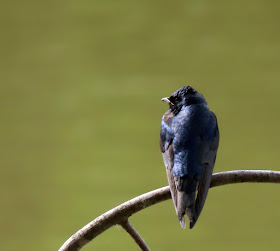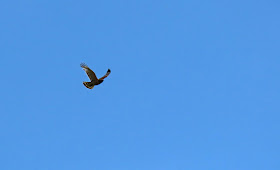 |
| Yellow-billed Cuckoo |
 |
| White spots on bottom of tail |
Dick has a friend from Bernheim who suggested we try a little town park in Shepherdsville, KY, right along the Salt River. He says his sister found some Yellow-billed Cuckoos there. I found the little park to be very pleasant. The Salt River, like all rivers around here, was running high, but the park was well maintained. As I walked along the trees growing by the river, I called for the cuckoo, but got no response. A few minutes later, however, a large brown bird circled around and landed above me, give me the eye -"You lookin' for me?" AllAboutBirds reports that they breed all over the eastern United States, and I think this was a breeding pair, since I heard another of them in the background. If you can't get a full view, look for the underside of the tail for big white spots. Much more instructive than the undertail you get from a warbler!
 |
| Purple Martin |
 |
| Purple Martin |
It's funny how we get into ruts when identifying birds. If it's dark blue and swooping around, I automatically say "Barn Swallow" and most of the time that would be correct. However, when I started to add this bird just now, I dawned on me that this bird has a face that is entirely dark, no rust on its face at all. In fact, it is a Purple Martin taking a rest from chasing bugs over the river, although there were plenty of Barn swallows around. Yeah, I'll change my eBird report! Native Americans hung up empty gourds for the Purple Martin before
Europeans arrived in North America. Purple Martins in eastern North
America now nest almost exclusively in birdhouses, but those in the West
use mostly natural cavities.
 |
| Blackpoll Warbler |
What else can I find that is exciting in this little park? Oh, there's a bird with a black cap. At first, it looks like a Chickadee, then I see the black and white stripes down the sides.
 |
| Blackpoll Warbler |
Is it? Could it be a Blackpoll Warbler? Yes! It favors conifers in northern forests, especially stunted spruce at higher elevations for
breeding, and is known for its exceptional migration over the Atlantic Ocean. They can travel from the East Coast of U.S. to South America in one nonstop
flight of about 3 days! I wonder if the Blackpolls nesting in central Canada travel to the east coast before migrating over the ocean, or if they take the land route.
 |
| Carolina Chickadee |
Well, this is a productive trip. Some little Chickadees are chasing each other, but one perches and ruffles its feathers and begs for food, apparently a fledgling following mama around.
 |
| Eastern Woods Pewee |
As you walk along the forest edge, you will constantly hear a little bird calling "Pee-a-wee!" But rarely do they come down for a look. This little guy got really brave and came to let me have what for, shouting at the top of its lungs! Note that it is a pretty non-descript, plain gray bird. If it weren't calling, I wouldn't have known what it was. In fact, until I looked it up, I didn't realize it is a flycatcher, and most of them look alike.
 |
| Eastern Phoebe |
Another flycatcher is the Eastern Phoebe, who calls out a raspy "Fee-Beee." It likes to nest near human habitation, so if you have to make a choice in the field, that can help. But watch for that constant tail bobbing characteristic of the Phoebe.
 |
| Red-shouldered Hawk |
Earlier in the morning, I noticed a couple of smaller birds chasing a Red-Shouldered Hawk. As I walked back to the car, I found both hawks in the air, showing off their beautiful soaring ability. 34 species on this trip to a small town park! A good day! And I got gas for cheaper at Kroger's there.




















No comments:
Post a Comment